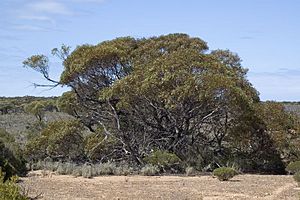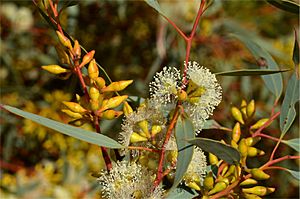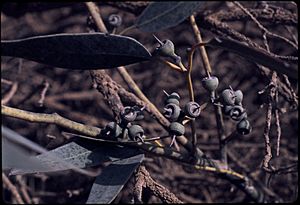Yalata mallee facts for kids
Quick facts for kids Yalata mallee |
|
|---|---|
 |
|
| Eucalyptus yalatensis on the Nullarbor Plain in South Australia | |
| Scientific classification | |
| Genus: |
Eucalyptus
|
| Species: |
yalatensis
|
The Eucalyptus yalatensis, also known as the Yalata mallee, is a special type of mallee or shrub. It's found only in southern Australia. This plant has rough, flaky bark on its lower stems, but smooth bark higher up. Its adult leaves are shaped like a spear, and its flowers are usually creamy white or yellowish. After flowering, it produces round, woody fruits.
Contents
What the Yalata Mallee Looks Like
The Yalata mallee is a type of mallee, which means it's a eucalyptus plant that grows with many stems from a large, woody base called a lignotuber. It usually grows up to 4 metres (13 ft) tall. Sometimes, it can be a low, spreading shrub that reaches up to 7 metres (23 ft) wide.
Bark and Leaves
This plant has rough, brownish-grey bark on some or all of its stems. Higher up, the bark is smooth and pale grey or brownish.
Young plants and new shoots have dull, greyish-green leaves that are egg-shaped. These leaves are about 43–80 mm (1.7–3.1 in) long and 14–40 mm (0.55–1.57 in) wide. They don't have a stalk, meaning they attach directly to the stem.
Adult leaves grow one after another along the stem. They are the same shade of grey or bluish-green on both sides. These leaves are shaped like a spear (lance-shaped), about 60–120 mm (2.4–4.7 in) long and 9–22 mm (0.35–0.87 in) wide. They narrow down to a stalk (called a petiole) that is about 10–20 mm (0.39–0.79 in) long.
Flowers and Fruit
The flower buds of the Yalata mallee grow in groups of nine or eleven. They appear where the leaves meet the stem. Each group of buds is on a short stalk, about 3–10 mm (0.12–0.39 in) long. The individual buds are also on tiny stalks, about 2–5 mm (0.079–0.197 in) long.
When the buds are ready, they are shaped like a spindle or an egg, about 7–12 mm (0.28–0.47 in) long and 3–6 mm (0.12–0.24 in) wide. They have a narrow, cone-shaped cap (called an operculum) that is longer than the base of the flower.
The Yalata mallee blooms between October and February. It produces beautiful creamy white or pale yellowish flowers.
After the flowers, the plant develops woody fruits. These fruits are shaped like a half-sphere or a flattened sphere, about 4–7 mm (0.16–0.28 in) long and wide. Inside, the seeds are oval, shiny grey-brown, and tiny, only about 1–2 mm (0.039–0.079 in) long.
How it Got its Name
The Eucalyptus yalatensis was first officially described in 1975. A scientist named Clifford Boomsma wrote about it in a publication called the South Australian Naturalist. He used plant samples collected by Bruce Jabez Copley in 1969. These samples were found near a place called Yalata. Both the scientific name (yalatensis) and the common name (Yalata mallee) come from this area where the first samples were collected.
Where the Yalata Mallee Grows
The Yalata mallee grows in mallee areas. These are places with many mallee plants, often on flat or slightly wavy land. Sometimes, it can even be found on limestone cliffs. It always grows in soil that is chalky or sandy, and usually over limestone.
You can find this plant from Balladonia and Israelite Bay in Western Australia, all the way to the Eyre Peninsula in South Australia. It also grows in a separate, smaller area near Mannum.
Conservation Status
The Western Australian Government's Department of Parks and Wildlife has looked at the Yalata mallee. They have classified this eucalyptus as "not threatened." This means it is not currently in danger of disappearing.



